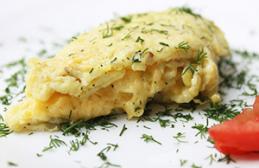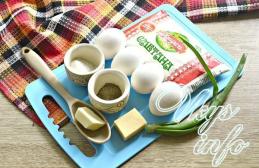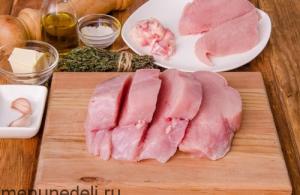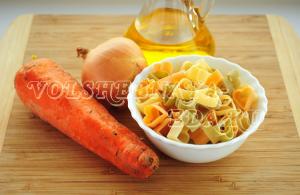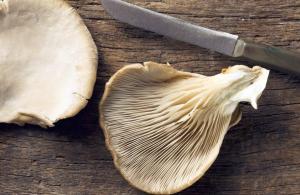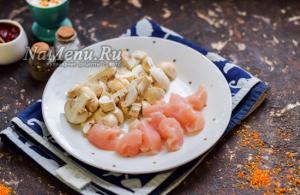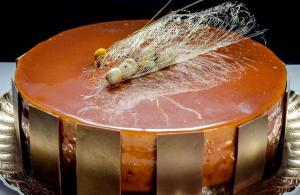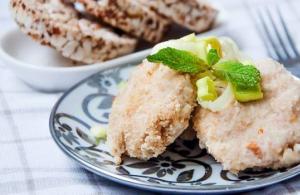Moscow is still not New York or London, no matter how passionately we desire it. No matter how a new place with “ethnic” cuisine opens, it immediately becomes clear that the authors tried very hard, but outside the window there are still Moscow traffic jams, and not China or Ethiopia. Any restaurant in the center is a clear confirmation of this. The more exotic the cuisine, the higher the prices. And it doesn’t matter that the food in this restaurant differs from what could be prepared in the country itself - the main thing is that the interior and the names of the dishes are similar. It seems that everything is not right. This is where we would all despair, but there is a st.m. “Belyaevo”, where I forget that I’m in Moscow – or whatever, in Russia. This is the area of the Peoples' Friendship University of Russia and adjacent dormitories.
About 20 minutes on foot or by car towards the Vityaz cinema - and you will meet stylish people from Africa, the Japanese, the Chinese, and there are so many of them, and they are all so fashionable, alien, cool! I remember there was one mulatto woman standing with bags from some “Pyaterochka”, in a simple plush suit and jewelry - she looked like a model. How do they do this?? Walk two steps, turn into the courtyard with an exhibition example of a Russian hut - and the restaurants begin. I love Arabic cuisine, it includes various salads, meat, baba ganouj, hummus, but not only do Belyaev cafes serve excellent national dishes, even ordinary fish or, say, Adjarian-style khachapuri (in case you suddenly change your mind about trying Arabic cuisine ) they cook amazingly delicious food. I recommend the Beirut and Campus cafes (especially the latter).
As we all know, the criterion for the “correctness” of a place with foreign cuisine is the fact that foreigners themselves go there (and don’t spit, but come again). It is the presence of Lebanese, Syrians, etc. determines the atmosphere of the establishment. The Campus Cafe is a spacious and roomy place in an oriental style (there is also a “European” hall, but the photographers and I didn’t go there - editor's note.), prices - within 400 rubles. per dish (by dish I mean not three sprigs of lettuce, but, say, meat with a side dish). Thus, veal kebab with a side dish cost 370 rubles, and lamb kebab - 320 rubles. Strong alcohol is served only after 20-00, but beer costs around 150 rubles. for 0.5. A cup of tea - 40 rubles, a teapot (400 ml) - 200 rubles. It is better to book a table in advance for the evening, the demand is very high.
Or, let’s say, the chefs at Chaikhona believe that they know how to cook tabbouleh salad (a salad made from parsley, tomatoes and an amazing grain called bulgur). It’s a pity to disappoint them, but in Lebanon (and I’ve been to Lebanon) and in Belyaevo they cook tabouli (170 rubles), and in many other places the cook was simply in a creative mood.
What else? Hookah - I’m just afraid of the unprecedented influx of visitors, but it’s unlikely to cost more than 500 rubles. Moreover, this is the RIGHT hookah. Well, in addition to all this happiness, in the evening a beautiful girl will dance a belly dance for you for free (and, importantly, not for long). During the warm season, the Campus has a summer terrace in a picturesque corner.
By the way, despite the fact that this is a dormitory area and all the cafes are originally for students, decent people (like you and me) go to local cafes. My only complaint is about the falafel (250 rubles)! It was very overcooked, although some people may like it that way. In Israel, for example, she (or he?) is of her natural light color. But at the Campus they gave her a bunch of mint for some reason. They also have falafel in pita bread (the pita bread there is excellent, by the way) in a smaller portion.
Also on the territory of the dormitories there is a restaurant (although this is loudly said) of Indian cuisine “Devi”, which is very close to the “Campus” and it’s a delight, what is it. The staff are the nicest Indians who don’t know Russian very well, but if anything happens, they can explain themselves with signs.
We took chicken, a tomato stuffed with cheese in a spicy sauce (heated!), fried ice cream (let's say, for an amateur - 170 rubles), a fried apple with ice cream (amusing - 170 rubles), two teas, two beers, and then they also persuaded us to buy a large pot of green tea, shuddered at the spiciness (yes, there is very spicy food there!) and paid 1,500 rubles for the three of us. As for the atmosphere - mostly Indians with families, there were also a couple of expats with children sitting nearby. The Chinese also serve Chinese food there too. There are televisions on the walls, on which Indian films with English subtitles and local news are broadcast non-stop. True, there was a slight embarrassment with the drinks: the masala tea (60 rubles) did not contain the promised ginger, but there was condensed milk in abundance, and the hibiscus was from a bag.
Instead of traditional chewing gum, they give out anise seeds with some nuts.
And then our friends told us how they ordered catering for a wedding from Devi and it turned out very inexpensively.
Next we looked at Beirut. The interior is a bit reminiscent of Shesh-Besh, but the prices are 2 times lower. Guests are greeted there by a very personable Lebanese man. Hookahs are very popular among guests - 200 - 500 rubles. There weren't many people there at seven on a Saturday night, but the best tables were already reserved.
We liked the lula kebab with a side dish (260 rubles) and the flatbread with cheese (180 rubles), but the ice cream with strawberries (190 rubles) - but, well, there are other places for “proper” ice cream in Moscow, in Eventually. We add two beers and one latte, and the total is 1000 rubles.
A restaurant syndicate of thirty establishments has grown up on the territory of RUDN University. Cafes bring in up to $1 million a year to the university. RBC magazine studied the business of restaurateurs and found out why McDonald's will never become their competitor
Naresh Chukkala is looking for all the chefs for Devi in their homeland due to the peculiarities of Indian cuisine
“Soviet Moscow from the point of view of public catering was terrible: eating [for a student], especially on a day off, was a problem,” recalls Alexander Gladush, vice-rector for student affairs at the Peoples’ Friendship University of Russia, in an interview with RBC magazine. At RUDN, “they paid great attention to nutrition,” but still, for almost 5 thousand students there were three canteens and four snack bars. Even then, they prepared ethnic dishes: at the most international university in the country, students from 155 countries study, the share of foreigners is 35% and continues to grow.
Five percent and no McDonald's
The first private cafe on campus opened in 1993, when “the state food system died out,” says Gladush. The pioneer was the Lebanese establishment "City", which is still operating. Over the years, more and more new outlets opened in its neighborhood, and gradually the concentration of ethnic restaurants became a “feature” of the university. Why did cafes take root in RUDN University? “Our students came from countries where cafes were the order of the day, where there was a food culture,” explains Gladush.
Today the university rents out about 10 thousand square meters for commercial lease of buffets, cafes and restaurants. m in the south-west of Moscow, estimates RUDN Vice-Rector for Commercial Activities Sergei Nazyuta. This area is shared by 33 establishments. Rental rate - from 10 thousand to 18 thousand rubles. for 1 sq. m per year, on average - 12 thousand rubles. According to Nazyuta, the rent brings RUDN about 60-70 million rubles. annually. Other universities do not have this practice: for example, Moscow State University rents out “a small area” to third-party restaurateurs, preferring to develop its own canteens and catering facility, said a representative of the university’s press service.
The RUDN campus on Miklouho-Maklaya Street is divided into two parts: in one there are educational buildings, in the other there are dormitories and a cafe, where any guest “from the street” can come. Some restaurants occupy basement spaces and install discreet signs, others - for example, Beirut - even decorate the façade of the building in their own style. Establishments at RUDN University are a godsend for lovers of authentic exotic food: local cafes specialize in Arabic, African, Indian, Chinese and other national cuisines. Some restaurants broadcast football, while others attract visitors with belly dancing.
Every year, RUDN University receives 300-500 proposals from those wishing to open a cafe. Among them are not only students, although 90% of the establishments are run by people from RUDN University, but also chains - McDonald's, KFC and others, says Nazyuta (representatives of McDonald's and KFC did not answer questions from RBC magazine). But the university deliberately gives preference to former and current students. Relying on them not only ensures the ethnic diversity of cafes, but also allows the university management to control restaurants. “Chain operators cannot change prices, but local businessmen must be flexible,” notes Nazyuta. The only chain for which RUDN made an exception is “ "Kroshka-Kartoshka": "They fit into the concept of the food court in the educational building." A representative of "Kroshka-Kartoshka" declined to comment.
Overall, about 95% of proposals are rejected. To get into the coveted 5%, the restaurateur needs to offer a concept that is “primarily interesting to students,” and take into account whether a sufficient number of students from “this culture” study at RUDN University, the vice-rector clarifies. All concepts are discussed at the academic council, the final decision is made by the supervisory board, chaired by the speaker of the Federation Council Valentina Matvienko. After internal procedures, the deal is approved by the Ministry of Education and the Federal Property Management Agency - a bureaucratic process that takes at least six months. “Tomorrow you won’t open a cafe,” warns Nazyuta.
In addition to rent, cafe owners reimburse utility bills. There are no other costs, but there are additional conditions: it is customary at RUDN to help needy students.
Building a restaurant business far from the center is not an easy task. The revenue of establishments on the territory of RUDN University depends on the time of year: summer, all of January and part of February are the low season, says Nazyuta. In addition, entrepreneurs need to be prepared for strict quality control: after each complaint, members of the student council come to the cafe with an inspection. Several times, cafes were closed due to failure to comply with internal regulations. “This is a real small business,” states Nazyut.

Mustafa Salloum's business went through several crises, after which he changed the concept of the establishment each time (Photo: Anastasia Tsayder for RBC)
"Two daughters and a son "Dionysus"
“Our competition is higher than on Tverskaya,” laughs the daughter of the owner of the Dionysus restaurant, Christina Sallum. She meets a correspondent for RBC magazine in a cafe on a weekday afternoon. The interior is designed in soothing colors, there are fresh flowers on the window sills, and there is a fireplace in the small room. Christina is sitting at one of the tables with a laptop; there are several visitors in the room. Soon her father Mustafa joins the conversation.
“Dionysus” is the only restaurant on the territory of RUDN University that keeps up with the times: the establishment has accounts on social networks, a corporate website, its own mobile application, loyalty cards and delivery. The founder of the cafe, 59-year-old Mustafa Salloum, came to Russia in 1980 from Lebanon.
He studied at RUDN University to become an ophthalmologist, in 1987 he married a Russian woman and decided not to return - there was a civil war in his homeland. Sallum worked in his specialty for about four years at City Clinical Hospital No. 1, received Russian citizenship, and then was forced to go into business: “It was not my path, but I had to support my family with something.”
Together with his wife, Mustafa began purchasing women's bags in China and selling them wholesale. “The market was empty, there was no abundance like there is now,” he recalls. During the 1998 default, Sallum invested all his free money in goods, the trucks of which, due to the collapse of the ruble exchange rate, turned out to be more profitable to leave at the border than to import into Russia: “We had a great time, after that I was depressed for two years.”
The decision to open a cafe came by chance. “As a former student, I had a good relationship with the RUDN administration,” says Mustafa. Besides, “all Lebanese are famous restaurateurs: if you say you’re Lebanese, people ask if you have a restaurant,” Christina jokes. Her father asked to rent a room and in 2001 received a small cafe with ten tables - the competition at that time was much lower. Mustafa named the restaurant Peti (from the French petit - “small.” - RBC).
The cafe was opened with students in mind; investments in the launch amounted to about $70 thousand. There were no other Lebanese restaurants nearby at that time: competitors, Campus and Beirut, opened later. A year and a half later, the business expanded: Mustafa rented the premises of a closed Afghan restaurant at the other end of the street, made renovations and opened Dionysus. The area has tripled compared to Peti, to 300 square meters. m.
“Dionysus” is a real family business: his wife and two daughters participate in the management together with Mustafa. Sometimes they did literally everything: the owner stood behind the bar, his wife worked in the kitchen, the eldest daughter in the hall, the youngest washed the dishes. There is a joke in the family that “the parents actually have three children - two daughters and a son “Dionysus,” says Christina. “When we got together at home, we discussed not where we would go or what we would buy, but business. Since childhood, my sister and I have seen that money is not candy wrappers,” she recalls.
RUDN University is also Christina’s alma mater: here she graduated from the Faculty of Economics, after which she received an MBA in Switzerland. It was Christina who came up with the current concept of Dionysus: Mustafa initially insisted that the menu should be “like the others.” “But this position is absolutely not working - the cafe did not make a profit for three years, we were on the verge of closing,” the entrepreneur complains.

Before opening his own cafe, Tefera Wasie worked for several years as a market seller and taxi driver. (Photo: Anastasia Tsayder for RBC)
In 2009, my mother asked: “You use the Internet, write there that we need a cook of any cuisine, just not Lebanese or Russian.” This is how the first exotic cuisine appeared in “Dionysus” - Peruvian. Its main advantage turned out to be the portion size: it is important for students to get “a lot of food” for little money, explains Mustafa. The next “transfer” of “Dionysus” was a chef from India: behind the restaurant there is a popular store of Indian spices, and Sallum successfully adjusted to the demand.
Mustafa calls high turnover one of the main problems - 10-15 employees constantly work in the cafe, but over 16 years about 2 thousand people have worked here. “If you seat everyone at the tables, at least five seats will change,” Christina smiles. She explains the turnover by the ambitions of the students: “People came modest, with holes in their shoes, and then they saw Moscow - and it seduced them.”
The Dionysus business has gone through three or four crises, says Mustafa: at these moments the family tried to be “as flexible as possible in relation to clients.” While the law allowed to have a license for alcohol on the territory of universities, cafes sold cocktails for 200 rubles. and had parties with DJs. Now “Dionysus” positions itself as a family restaurant - the menu includes dishes for children. The average bill is 500-650 rubles. 150-200 guests come to the cafe per day, depending on the season.
Mustafa refuses to talk about the terms of the lease and the amount of revenue. “When you have one cafe, you can only support the needs of the family. If you want to earn big money, you need to go into online history,” the Lebanese businessman shrugs.

Business looking for a suite maker
Naresh Chukkala never studied in the USSR; he came to the country in 1990 to start a business. “At home, in India, they said that you have capitalism and everyone is rich,” the 65-year-old entrepreneur smiles.
Naresh lived in Kyiv for about a year, where he met his future wife Olga. After moving to Moscow, he decided to cook dinners from Indian dishes for friends. The starting capital was $20, and the kitchen was located in a rented apartment. Naresh started with five lunches a day for $3 and quickly reached 150 lunches. The neighbors' dissatisfaction grew no less rapidly: they complained about the pungent odors and demanded that the district police officer impose sanctions on the newly minted cook.
Chukkala began wandering around renting houses in different areas of Moscow, until in 1994 his acquaintances told him about the opportunity to rent a small extension on the territory of the RUDN University. There was a cafe called Annapurna, whose owner was closing his business.
“We worked in this extension for three years, and then they began to demolish them, and we were offered to rent the premises,” recalls wife Naresha.
Cafe "Devi" is located in a basement space of 250 square meters. m and consists of three halls. In the main room there are two plasma TVs with Indian channels. The owners proudly say that even the lead actress in the film “Zita and Gita,” Hema Malini, visited them. Naresh does not disclose the full investment in the cafe. For example, equipping the building with a fire safety system cost $7-8 thousand. Olga’s relatives, who were involved in construction, helped make the repairs. Naresh brought all the decorative elements from India.
There are few visitors on Wednesday evenings, but customers come who pre-order lunch for ten people. The waiter carefully writes down the order on a piece of paper. “We are not friends with technology,” Olga admits. The restaurant does not have an app or the ability to order food on the website - “it’s better to call.” Less than a year ago, a terminal for card payments appeared, but waiters can’t always cope with it. Delivery at Devi is organized in-house, although it has been available since the cafe opened in 2000. If the order needs to be carried nearby, the waiters do this; if the client orders food to the other end of Moscow, the price of a taxi is added to the cost. There are few orders, so it is not profitable to have a courier, Olga believes.
At its peak, until 2009, Devi served about 150 lunches a day, sometimes the number reached 300. But over time, many clients began having corporate lunches, and some switched to home-cooked food, says Naresh’s wife. Today the average daily norm is only 25 lunches. Price - about 400 rubles.
Another source of income for the Chukkala family is catering. Naresh is invited to Indian and foreign embassies, weddings and outdoor events. The cost of catering is 1.5-2 thousand rubles. per person. In 2010, several Devi chefs went to St. Petersburg for a month and a half: an Indian film was being filmed in the city, and the employees cooked for the film crew. An apartment was rented for them on Nevsky Prospekt, where the cooks arrived with pots and equipment.
Finding Indian cuisine specialists is one of the main problems of business. From the moment of submitting an application to hire a foreigner until he starts working, at least a year passes. The employment center sends people who formally fit the candidate’s description, but, in fact, do not know how to cook, Olga complains. “In India, sweets are prepared by a sweet maker, in Russian - by a confectioner. We send an application to the employment service for the specialty “confectioner”, and people come who see our national sweets for the first time in their lives,” Naresh confirms upset.
He also rents housing to his subordinates (an apartment costs about 50 thousand rubles per month), and if they get sick, he pays for treatment and operations. Naresh does not have Russian citizenship: as a foreigner, he applies for a visa, which “does not bring any inconvenience,” says the businessman.
“Working so far from the metro is not easy,” adds Naresh’s wife. Rent - about 10 thousand rubles. for 1 sq. m per year - “a significant amount for such a business.” Attendance at Devi depends on the season and day of the week. On Mondays, one or two people come in; on weekends, all three rooms can be occupied. In the first few years, Olga kept statistics on clients, but stopped: “When there are no clients, it becomes sad.”
Cafes and restaurants of RUDN University in numbers:
10,000 sq. m rents out cafes and restaurants of RUDN University
Establishments bring in up to $1 million a year
Rental rate - from 10 thousand to 18 thousand rubles. for 1 sq. m per year
RUDN University receives 300-500 proposals a year from those wishing to open a cafe
In 1993, the first private cafe opened on the territory of RUDN University
33 institutions operate on campus now.
Ethiopian "Avenue"
Tefera Wasie, 54, never thought he would live in Russia. He came to Moscow in 1986 from Ethiopia. By that time, Tefera had graduated from university and worked in a textile factory for a year and a half. At RUDN, he decided to master the profession of mining engineer, which was in demand in his homeland. “I moved into this hostel, and this tree was very small,” the entrepreneur points out the building and the tall elm tree outside the window, meeting a correspondent for RBC magazine in the Avenue cafe. At six o'clock in the evening on a weekday, several tables are occupied in the establishment. The walls are decorated with paintings from Ethiopia, and at the bar counter there is a transparent cabinet with national souvenirs - customers can buy them.
Tefera remembers his student years with a smile and admits that three things struck him most about Russia. The first is snow; he remembers exactly the day he first saw him - September 22, 1986: “I went outside and caught snow with my hands. I liked it the first time, but with the onset of winter it became very difficult.” The second discovery was the diversity of nationalities among people with light skin: “In Ethiopia, I thought that all whites were “Russian.” The third thing was the complexity of the Russian language. Tefera's teacher cried from powerlessness during class, but six months later the African student finally began to make progress.
In total, the future restaurateur spent six years at RUDN University. Immediately after graduating from university, he married his fiancée Anna, whom he met through mutual friends. After a short trip home, Tefera returned to Russia - power had changed in Ethiopia, and Anna would have a hard time coping with her husband’s business trips to gold and rock deposits. In Moscow, the couple decided to sell on the market goods from Korea that their friends brought to Russia. “I didn’t want to [trade], but we already had a small child, and we had to survive,” recalls Anna. Every day for four years, Tefera occupied a tent at the Pokrovsky market. In winter, he wore a hat with earflaps, a sheepskin coat and felt boots. Buyers were attracted by the Ethiopian seller, in addition, Wasie told everyone that he personally brought all the things from Africa and “this is not a fake.”
Vasie was not a citizen of Russia, but received a residence permit in Togliatti, where Anna is from. The police regularly tried to fine him due to lack of registration in Moscow, so the entrepreneur learned to give money to his wife at the end of the day in order to close the tent without proceeds. By 1997, the couple bought an apartment in the capital.
Tefera was constantly sick due to working in the cold and, on the advice of doctors, began to think about leaving for another business. I tried to work as a taxi driver and set myself a level of 5 thousand rubles. a day and did not return home until he took it. “And I couldn’t sleep at night,” recalls Anna. Tefera got into accidents several times, was robbed, and refused to pay. Therefore, when a fellow countryman suggested opening a cafe together at RUDN University, he immediately agreed.
Avenue took over the former gym space in 2003. The partners invested $11 thousand in repairs and startup and another $100 thousand in the first year of operation. The investments were recouped within three years, and in the fourth the entrepreneurs quarreled over profits. The area was divided in half: Tefera had about 120 square meters left. m, where he kept the cafe, the partner opened a store on his territory.
The name “Avenue” was invented by a former partner, says Vasie: the word sounds the same in many languages, which is quite consistent with the spirit of RUDN University. The restaurant initially did not have an ethnic concept - it relied on European cuisine. But at Tefera’s suggestion, they started cooking Ethiopian dishes on weekends. They turned out to be in demand and two months later they were included in the main menu. The cook was found among the RUDN students.
In addition to Ethiopian food, other African dishes also appeared on the menu over time. Vasier was pushed to take this step by his student clients: they constantly asked when “Avenue” would serve pepper soup, traditional for many African countries. To expand, we had to hire a third chef.
Rent is Vasie's third-largest expense, with more money spent on groceries and salaries for seven employees. "Avenue" brings in a profit of about 1 million rubles. per year, says Anna. The cafe owners do not disclose other financial indicators. They try to retain customers with low prices. “If a student cares about his health, he can afford any soup from us,” Anna assures. She calls the location on the territory of RUDN University a “great success” for business: “I’m not sure of success, if we worked in the center of Moscow.”
“Africans are very noisy and lively. If there is a football match, the walls here shake,” Vasie’s wife adds with a smile. Tefera confirms that if local students enter a cafe at this moment, they immediately turn around: “But I suggest putting them in a small hall, where it is not so noisy. And after a while they themselves move to the big one, where the main movement is.”
About the gastronomic cluster
“From the founding of RUDN in 1960 until the 90s, there were only a few canteens on the university campus. Restaurants began appearing here in the early 90s. Due to the multinational student body, there was always some kind of movement in the dormitories, and as soon as the state allowed the opening of cafes and businesses, it all flourished. It is difficult to say which places appeared first. But there are iconic cafes: “Campus”, “Dionysus”, “Beirut” and “Mirage”, which seem to have always been there. In the early 2000s, the first chain establishments began to appear from the center of Moscow. In 2006, Sbarro, Kroshka Potatoes, and Subway appeared. Some still exist. For example, “Shokoladnitsa” fits very harmoniously with its format of street coffee, which, unfortunately, is not yet developed in RUDN University. Something is constantly closing, new things are opening.”
“When I entered, they told me that there were 60 cafes on the territory of RUDN University. They informed me not to go on a spree: you could go to a cafe instead of going to study. There are 25,000 students at RUDN University - and everyone needs to be pleased. There is a cafe in every dorm. Here, even the most expensive cafe is cheaper than anywhere in Moscow. In the summer, when students leave, restaurants make promotions to attract customers in order to work at least to break even. Summer is the most unprofitable time for administrators and owners. In winter evenings it is difficult to find places here, especially where there is a TV and football is broadcast. During sessions and inspections, we are prohibited. Many establishments do not have alcohol licenses - and just a month ago even graduates could not buy beer.”
“I studied philology at RUDN University, and am now in graduate school at the same philological department. Once the guys from Tripster contacted me and asked me to prepare a tour of the interesting ethnic cafes of the RUDN University. After the excursion was talked about on Rossiya 1 and Russia Beyond the Headlines, other excursion companies began to come forward for the original tour. Now on the route I am working with a colleague, also Irina. For the second year now there has been no end to tourists. They also book private excursions with a variety of dishes for tasting, and they also come in groups of 40 people.”
"Dionysus No. 1"
Indian, Mexican and Peruvian cuisine
1 of 5
2 out of 5
3 out of 5
4 out of 5
5 out of 5
Valentin Ozerov, IT project manager:“I visit Dionysus all the time. We have never eaten such delicious Mexican food. “Dionysus” sunk into my soul, especially since it’s not far from home. The portions are large, the choice of dishes is huge, the quality is excellent. We received a discount card and go there about once a month. My women, wife, children and mother-in-law, love Mexican cuisine: burritos, quesadillas, fajitas. I experiment all the time, I've tried half the menu. I always order mango lassi and tea; there is a huge selection of original teas with milk and fruit. They also have outright failures, for example, Peking duck is fatty and tasteless. But basically, you can poke at any dish and the evening stops seeming bad.
Unfortunately, the crisis affected “Dionysus”: prices remained the same, but the size of the dishes noticeably decreased. But they now have food delivery, online ordering and reservations, a Facebook page and a new convenient website. The premises have recently been renovated. The guys are developing, which makes me happy. The cafe is visited by students of all nationalities, young people, occasionally we meet at “family gatherings”, banquets are constantly held.”
“Now I have two favorite institutions on the RUDN student campus. First of all, this is a restaurant with the amazing name “Dionysus No. 1”. It serves dishes of different national cuisines, but you must order from the Peruvian menu. The ceviche there is especially wonderful, slices of raw fish briefly marinated in lime juice.”
1 of 3
2 of 3
3 of 3
Maria Molotkova, master's student at RUDN University:“I first came to Dionysus when I first came to study at RUDN University. At the hostel they assigned me a Mexican girl, and we are still close friends. We went there together. Naturally, when I saw the menu, my eyes ran wide from the huge assortment of dishes from different cuisines of the world. As I remember now, the first thing I tried was chao fa - a Chinese dish. Another time we “visited” India - if not the most delicious chicken tikka masala. In general, I fell head over heels in love with this place - and from now on we only went there, since the staff, the atmosphere of the place, and, of course, the cuisine were at their best.
My husband and I have a cult of food in our family; we are also food lovers. At Dionysus we often order Americano pizza with onions, tacos, lasagna, chao-fa and Indian dishes. My favorite teas are ginger-pear and berry. We also have our favorite dessert - chocolate rolls with fruit, I highly recommend it. The most delicate chocolate dough, and inside there is a fruit mix of kiwi, apple and banana, served with orange slices.”
Tatyana Roik, owner of PR agency Lotus Communications:“We’ve never been to the cafe itself, but we’ve ordered food from there twice through the Delivery Club. We are vegetarians, and they are just a godsend for us - there are many dishes on the menu for those who do not eat meat and fish. I am conservative when choosing food, and if I like something, I order it again and again. Therefore, both times we took Adyghe cheese in tandoor (paneer-tikka), baked eggplants with tomatoes (beigan-burta) and lemon rice. This is quite enough for two. My boyfriend also liked the stewed lamb in a spicy Indian sauce with ginger (matton buna). The portions are large. But the most important thing, of course, is that they are very tasty. You can feel the food being prepared with love, which is something you don’t see very often.”
"Beirut"
Real Lebanon in Moscow
1 of 6
2 of 6
3 out of 6
4 out of 6
5 out of 6
6 out of 6
Karen Kocharyan, 1st year master's student at RUDN University:“About 80% of institutions in RUDN University are Lebanese. The university management trusts the Lebanese in terms of their attitude towards business. Plus Lebanese cuisine is very rich. Beirut is a good example of this. The restaurant is about 20 years old, and not only graduates, but people from all over Moscow come to it. "Beirut" is divided into two halls - European, light, and Lebanese, dark. In European music is quieter. There is a lot of food, everything is very tasty. I love lentil soup - you won’t find this anywhere else in Moscow. Great hummus. Very customer-oriented service, they can make concessions if they have known you for a long time: for example, we were allowed to bring our own cake for our birthday.”
Mikhail Alekseevsky, urban anthropologist:“I started systematically going to local ethnic restaurants in the mid-2000s. My first love was the Lebanese restaurant Beirut; a classmate introduced me to it. It was an incredibly colorful establishment “for the insiders”: there was smoke from hookahs, sweet Arabic pop music was playing loudly, and in the evening, as entertainment, belly dancing was shown between the tables. In terms of food, it was excellent, inexpensive and very tasty, especially good were the meat dishes and the Lebanese mesa, an assortment of various snacks: from hummus (called khommus here) to moutabal, charcoal-roasted eggplant with sesame paste in olive oil. “Beirut” is still working, and it’s still very tasty, but in terms of flavor, it’s slowed down a little.”
1 of 4
2 of 4
3 of 4
4 out of 4
Nassar Mahmoud, Events Manager:“I myself am from Egypt, I’ve been living in Moscow for about six years. Lebanese cuisine is almost native to me. One day I was looking for Lebanese food on the internet and found Cafe Beirut. What I tried there is authentic Lebanese food. The atmosphere is Lebanese, as is the music and the presentation of food. Try the salads zaytoun, tabbouleh, fattoush, cold appetizers babaganoush, lyabneh, Lebanese maza, hot appetizers manakysh, ful, hot dishes kafta-heshkhash, and for dessert - knafeh, knafeh and again knafeh. "Beirut" - a real oriental journey in Moscow."
"Avenue"
Ethiopian cuisine: firfyr, tibs, pepper soup and fufu
Irina Leksina, author of a gastronomic tour of the RUDN University campus:“A must-visit place if you find yourself on campus. If you can try Chinese, Lebanese, Indian cuisine somewhere else in Moscow, then it is unlikely that you have encountered Ethiopian cuisine anywhere. Beyayanetu, firfyr, tibs, pepper soup, fufu, drinks - Ethiopian coffee, Tej honey drink and much more. Exoticism in its purest form. The names are intriguing. The owner of this establishment, Tefera Yehuala Wasie, is a real Ethiopian who once studied at the RUDN University, and then successfully married a beautiful Russian girl and remained in Russia. And for good reason. Not only our African students, who are happy with their familiar cuisine, are grateful to him, but also those who are just as curious about gastronomic experiments as our excursionists.
I always recommend trying tibs here - a festive dish of lamb with hot pepper dressing on a small roaster. It is served with unleavened flatbread called injera, which is used instead of a plate, fork and bread (they must eat it with their hands, grabbing the meat with the flatbread). I suggest washing it down with the low-alcohol drink Tibs - something like our mead, but more spicy. I advise aesthetes to order an Ethiopian coffee ceremony (Attention! It is salty!). And I treat special gourmets to fried bananas with spicy seasoning - banana fries.”
Karen Kocharyan, 1st year master's student at RUDN University:“There are a lot of Africans in Avenue. A bright establishment, no curtains. You can watch football. Africans love football very much and often gather there.”
Irina Taran, gastronomic tour guide on the RUDN University campus:“One of the most interesting cafes here, in my opinion. There are several reasons. A hospitable host who will answer all your questions, show you his collection of Ethiopian souvenirs, take a photo with you and even treat you if he likes you. An inimitable atmosphere in the evenings, when there are a lot of visitors, Ethiopian music, emotional regulars - the mood is guaranteed! And bringing your friends here without telling them where you are going is the best way to leave an unforgettable impression of the evening. And of course - food. At first, everyone cautiously examines the dish placed in front of them, but then they don’t leave anything on the plate, of course, if they like it spicy. The best dish for those who are here for the first time is beyayanetu. This is an assortment of Ethiopian dishes. Spicy, but tasty and informative. And of course, be sure to order a jug of coffee for the company, which you can drink all evening from small cups.”
"Bogatyr #1"
Popular shawarma
Araksia Movsesyan:“Everyone at RUDN University loves shawarma, they make it very tasty here. The most popular is shawarma from “Bogatyr #1”: everyone knows it. The tent is located opposite the main building of RUDN University. Shawarma costs about 130 rubles. There is regular and cheese in orange lavash, delicious, I just take it. At times there are small queues, if you can call them that, of 4-5 people. It looks like an Uzbek is cooking.”
Devi
Indian and Chinese cuisine
1 of 5
2 out of 5
3 out of 5
4 out of 5
5 out of 5
Anastasia Repko, financial consultant, project manager:“I came here on the recommendation of friends; even at the institute there were legends about this place as a truly authentic Indian place. And of course, prices are also important for students. Years go by, but the cuisine here is still the same authentic, there is something in the atmosphere that does not bother you at all - the simplicity of the place. Very tasty, there are a lot of Indians around, Indian movies are shown on TV. The place hasn't changed at all - and I like it. Well, maybe Chinese cuisine has been added. I don't remember it being there before.
Interestingly, my husband, an American, also turned out to be a fan of Devi. He rented an apartment in this area. We try to take visiting guests there as well, if time permits. My favorites are naan, palak paneer and various curries and other dishes whose names I forget. My husband has his own set, including chicken tikka masala and papadam. Plus it's always sweet and sour soup and lassi. We once took a man there who had lived in India for a long time, and he said that everything tastes just like there.”
Irina Leksina, author of a gastronomic tour of the RUDN University campus:“From Chinese, I can recommend the Sky View restaurant on the 33rd floor of the Central House of Tourists - very close to RUDN University, but not on its territory. And one of those on campus is the Devi restaurant. Although it has an Indian name, its extensive menu consists of 50/50 Chinese and Indian dishes. There are about 200 pieces in total. Menu without pictures, with unusual names. It’s difficult for the uninitiated to understand, but they have a website, so you can prepare for a trip to the cafe. We always take various sweets and masalas there; among the main dishes, chicken curry, soups with tofu and rice in its various variations are especially popular.”
1 of 7
2 of 7
3 out of 7
4 out of 7
5 out of 7
6 out of 7
7 out of 7
Anastasia Zagrubskaya, tax lawyer:“I don’t go to Devi very often - it still takes a long time to get there, even by car. I came across it for the first time by accident - vegan friends dragged me to it. Over the years that I have been going to Devi, they have not changed at all: the same burgundy tablecloths and loud conversations in Hindi mixed with Russian coming from the kitchen. I always try new things: their menu is huge, everything seems to be delicious. The last time there was a delicious chicken seekh kebab, but I remember it primarily because of the name.”
Maxim Kosyakov, RUDN graduate:“Devi is located in the basement, with a completely authentic design. Once I was very surprised when I went there on the weekend: there was nowhere to sit. A lot of Indians come there to have lunch. I myself am fond of Indian cuisine and have tried it in many places in Moscow, and I can say that Devi has the most delicious food.”
"Mirage"
Arabic and European cuisine

Anna Rybkina, RUDN student:“I first came to Mirage when my brother was graduating from RUDN University back in 2004. In my opinion, it is better to take food with you at Mirage, not because the interior is bad or there are a lot of people, but because the waiters there are terribly slow and sometimes get the table confused. My classmates and I called these waitresses fish. Nevertheless, I recommend Mirage to all my friends who want to eat cheaply and experience student life.”
Karen Kocharyan, 1st year master's student at RUDN University:“Mirage is still one of the most popular establishments on the territory. Although the food is ordinary, the prices are student prices. A business lunch, for example, costs 175 rubles. I ate there all the time my freshman year.”
"Mazage"
Arabic with Italian cuisine and shawarma
Alexey Bisaliv, RUDN graduate:“I once studied at this university, and the tradition of going to inexpensive, but very exotic restaurants on the RUDN campus remains. There are about 24 ethnic cafes on the territory with Indian, Afghani, African, European, Arabic, Chinese and other cuisines, not counting the ordinary ones. There are small establishments, medium ones, such as “Mazaj”, and huge ones, such as the cafe-restaurants “Beirut”, “Campus” and “Galaktika”. There is everything here: Wi-Fi, dancing, belly dancing, various discounts and offers from chefs, and the most interesting thing - the atmosphere. The prices in these establishments and the variety of dishes are attractive, something you rarely see in Moscow. Moreover, if we talk about the foreign students visiting these cafes, then you feel not in Moscow, and this is what captivates them. My favorite place is "Mazazh".
"Galaxy"
Oriental dancing and hookah

Nina Ermak, RUDN graduate:"Galaxy" is located in the building of the Faculty of Humanities and Social Sciences. Students sit here, passing time between classes. Upon entering, you find yourself in a large room reminiscent of a nightclub: dim lights, black walls, music. Here, basically everyone eats sushi, smokes hookah, chats and listens to music, but during the day there is a separate room with regular food, like a modern canteen. On the lower, ground floor, everything is done in the Arabic style with large round tables and sofas, oriental dances in the evenings, which a large number of people from all over Moscow come to watch.”
"Campus"
Huge restaurant with hummus, rolls and shawarma
1 of 6
2 of 6
3 out of 6
4 out of 6
5 out of 6
6 out of 6
Karen Kocharyan, 1st year master's student at RUDN University:“There are five halls in the “Campus”, this is the largest establishment in RUDN University, and everyone will find in it everything they need, any cuisine. Huge menu. Oriental dances in the evenings, mainly on Fridays and Saturdays.”
Bondarenko Yunna, graduate of RUDN University:“This is perhaps the most popular place in RUDN University. It is difficult to say that any particular audience gathers in a particular cafe. In every cafe you can meet completely different people from different countries. This is not to say that only Indians or Chinese dine here; in every cafe there is a whole little planet. I can only add that not only students, but simply people from all over Moscow like to come to “Campus” and “Galaktika”. And the top dishes are probably the most ordinary food: all kinds of flatbreads, Arabic sweets, soups, kebabs, pasta, gohan and sushi, since all the young and poor students and all the food seems delicious. Here in the cafe they socialize more, smoke hookah and drink tea.”
It's easy to find the meaning under the name, but only if you know where to go. If you only have the address on hand: Miklouho-Maklaya, 21A, then you will have to wander a little in search of a detached interior blue shabby Soviet-built cube, to the back of which is glued a brick appendage with a yellowish sign and a narrow, shabby staircase leading to the basement. Downstairs, guests will find a blue stepped dressing room with a photo advertising Coca-Cola, a tiled floor mixed with linoleum, small decorations, no windows and two small halls. The main dining room, where I found myself, contained two counters with drinks and desserts, several fragile tables and chairs, a TV, a chandelier and air conditioning. Decorations include rare pictures on the walls and artificial greenery. Despite the fact that there was a feeling of dilapidation and cheapness in the air, the cafe was clean, not hot, not noisy and free of foreign odors.

The menu turned out to be large, Indo-Chinese, plastic and sticky. The choice is extensive. Prices are average. The stated weight of some dishes was questionable.

Butter Naan is a decent quality homemade flatbread, moderately oily, soft, and clearly made to order.
Aloo Paratha is another homemade flatbread, this time with a tangy filling infused with butter and the mouth-watering flavors of India.
Chicken Tikka – six red pieces of soft spicy slightly dry chicken in spices and herbs.
Chicken Curry – A small bowl of thick orange sauce with a splash of chicken. The sauce was curry-oriented, but not as vibrant as I would have liked. The chicken turned out tough, limp and tight in places.
Mutton Rogan Josh was another small portion of a thick burgundy mess with tough chunks of lamb floating in it. Edible, but too oily and somehow sour. You can try, but you wouldn’t be able to do it a second time.
Chicken Tikka Masala is a combination of rich tomato-creamy spicy sauce and low-quality gray, dry chicken with a hint of expired defrosted product.
Mutton Biryani - although the menu stated that the portion weighed 400 grams, I personally received a modest small bowl of spicy fluffy basmati rice with moderately soft pieces of lamb, but high acidity, which was not only disturbing, but also alarming.
The service on my visit was kind but unprofessional. Upon arrival, there were no staff in the room. I had to walk around looking for employees, look around corners, lean over the counter. After some time, it turned out that the entire service was entrusted to one single lady, not the most tidy looking, who spoke Russian with difficulty. She was polite, constantly smiling, but she brought out the food haphazardly, did not change anything, did not clean anything, periodically disappeared “backstage”, and forgot about the bill.
The result is this:
In a simple cheap basement of the student “Interclub” of RUDN University, weak service and edible Indian food without any attraction live side by side.
View this post on Instagram

